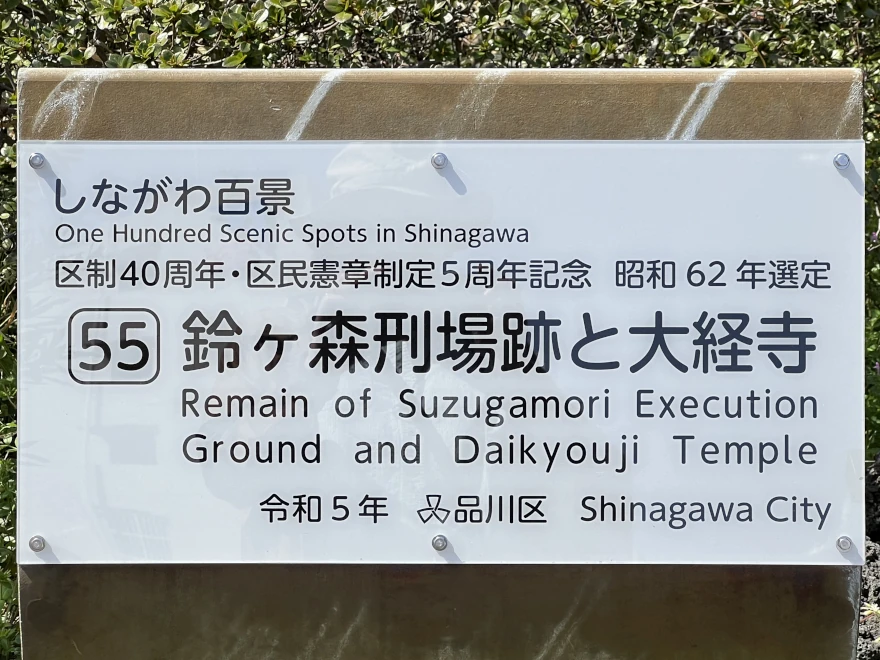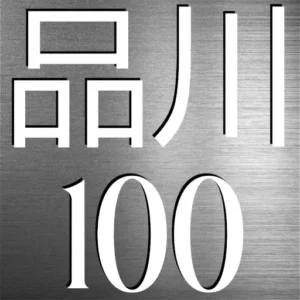🪦 Remains of Suzugamori Execution Ground and Daikyoji Temple – A Grim Gateway to Edo
Standing quietly beside a busy highway in Shinagawa, the Suzugamori Execution Ground (鈴ヶ森刑場跡) is one of the most chilling and historically significant locations in Tokyo. From 1651 until its closure in 1871, this site served as one of two official execution grounds of Edo—the other being Kozukappara in present-day Arakawa. Located along the Tōkaidō, the road south in and out of Edo, Suzugamori was intentionally placed where travelers and incoming rōnin would see it. Its purpose was not only punishment, but deterrence.
🌊 Execution by Sea and Fire
The Suzugamori site was chosen after earlier facilities in Takanawa and Shiba became overcrowded. Measuring roughly 74 meters wide and 16 meters deep, it sat originally on the shoreline of Edo Bay. The sea, in fact, played a direct role in executions here. Some victims were subjected to mizuharitsuke—a cruel form of “water crucifixion”—in which the condemned were tied to stakes and slowly drowned by the incoming tide. Others were burned alive or displayed after death. Even after centuries, the methods sound horrific. Today, a preserved stone pedestal marks the place where a crucifixion post once stood, and iron columns recall the flames once used to reduce bodies to ash.
🎭 The Suzugamori Dead Who Became Legends
⚔️ Marubashi Chūya and the First Execution
Over its 220-year operation, an estimated 100,000 to 200,000 people were executed here. Exact records are scarce, but the names of several infamous figures echo through history. The first recorded execution at Suzugamori was that of Marubashi Chūya, a rōnin and one of the conspirators behind the 1651 Keian Uprising. Although he died during his arrest, his body was publicly crucified here as a stern warning to those who might challenge Tokugawa rule. His fate marked the beginning of Suzugamori’s long and brutal legacy as the southern gateway of Edo justice.
🔥 Yaoya Oshichi and the Price of Passion
Another tragic figure was Yaoya Oshichi, a teenage greengrocer’s daughter who, in a desperate bid to see a young temple page she had fallen in love with, set fire to her home in the winter of 1682–83. Arson was a capital offense in Edo, and she was burned alive at Suzugamori in 1683, despite being just sixteen.
Her story was later immortalized in Ihara Saikaku’s Five Women Who Loved Love (Kōshoku Gonin Onna), and in numerous bunraku and kabuki plays, especially Date Musume Koi no Higanoko. Oshichi became a powerful symbol of youthful passion and tragic consequence. A large memorial stone inscribed with 南無妙法蓮華経 (Nam Myōhō Renge Kyō) stands near the site, quietly honoring her and the thousands of others whose stories ended here.
🎭 Gonpachi, Chōbei, and Kabuki Immortality
Suzugamori’s legacy also lives on through the stories of other dramatic figures. One of the most enduring is Shirai Gonpachi (real name Hirai Gonpachi), a youthful swordsman whose exploits and tragic fate captured the imagination of Edo society. His character became a fixture in kabuki theater and ukiyo-e prints, often portrayed as the embodiment of doomed romance and reckless valor.
Today, a towering granite slab inscribed with the Nichiren Buddhist chant 南無妙法蓮華経 (Nam Myōhō Renge Kyō) stands as a solemn memorial at the site. This monument also serves as a familiar backdrop in the 1823 kabuki play Ukiyozuka Hiyoku no Inazuma, where Shirai Gonpachi and the outlaw Banzui-in Chōbei confront their fates at Suzugamori. The stone’s presence in both historical memory and dramatic tradition deepens the site’s haunting resonance.
Whispers That Linger
Tales of ghosts and wandering spirits persist, and the place still draws amateur ghost hunters and curious students, though it is not promoted as a haunted spot. Locals may speak of it with solemnity rather than fear. Despite the macabre history, the execution ground is not hidden—there’s even a signpost on the main road, just north of Omorikaigan Station.
🔔 The Origins of Suzugamori
The name “Suzugamori” itself predates the executions. Originally the area was called Ipponmatsu (“One Pine Tree”) for a lone old pine near the coast. Over time, it came to be called Suzugamori, either due to a shrine nearby—Suzugamori Hachiman, now Iwai Jinja—which housed a bell-like ironstone, or, in a more colourful version, from bells hung on a tea house curtain that entertained Tokugawa Ieyasu’s army in 1600 as they marched toward the Battle of Sekigahara. Whichever version you believe, the name stuck long before blood stained the soil.
🙏 Daikyōji Temple’s Quiet Mission
Adjacent to the site is Daikyōji Temple (大経寺), built as a place of memorial for those executed. Founded around the same time the site opened, it belongs to the Nichiren sect and continues its spiritual role today. The temple grounds contain multiple stone memorials, including one dedicated to Oshichi, and rows of ema (wooden prayer plaques) where visitors leave wishes, prayers, or personal messages. Rather than glorify suffering, the temple offers quiet reflection and remembrance.
🪨 Stones that Refuse to Forget
The execution ground itself is small today, but remarkably intact. It sits within Daikyōji’s grounds and is free to visit. The stone bases and pillars were relocated slightly from their original positions, and a flower offering table has been added. In 1954, the site was officially designated a Tokyo Metropolitan Historic Site (東京都指定旧跡), cementing its place in Japan’s cultural memory.
What you’ll find is not spectacle, but quiet. A patch of gravel, a well, some ancient stonework. And yet—beneath your feet—centuries of stories. Come not to be entertained, but to bear witness.
🙏 Temple Notes
- Sect: Nichiren Buddhism
- Principal Deity: Shakyamuni Buddha
- Founded: Mid-17th century (c.1651) alongside the execution ground
- Major Features: Memorial stone for Oshichi, stone execution pedestal, execution post, prayer plaques
🧭 Visitor Information
Address: 2-5-6 Minami-Oi, Shinagawa-ku, Tokyo 140-0013
Access: 2-minute walk from Omorikaigan Station (Keikyū Main Line)
Best season: Any – it’s not a scenic site, but a sobering one
Admission: Free
Official Info: Daikyōji Temple Official Site
Note: This site contains memorials and remains. Please be respectful.
Where is it?
| what3words | ///rapid.extend.nothing |
| latitude longitude | 35.591781, 139.736572 |
| Nearest station(s) | Omorikaigan Station (Keikyū Main Line) |
| Nearest public conveniences | Public toilets in nearby Shinagawa Kumin Park |
Show me a sign.

It’s there.
Withervee says…
This one sits heavy. You won’t need a guide to feel the weight of what happened here. The stones under your feet knew fire, blood, and silence. Daikyōji offers a strange serenity in contrast—prayer, not punishment. If you want to understand Tokyo’s forgotten corners, this is a good place to start.
Don’t come for photos. Come for reflection.
🌟 Site character
- Lifestyle 生活 (Seikatsu): ❌
- Historical Significance 歴史 (Rekishi): ✔️
- Atmosphere/Natural Features 風土 (Fūdo): ✔️
🗳️ Who in their right mind would vote for this?
- History buffs
- Kabuki fans
- Temple seekers
- Urban archaeologists
- Ghost-story lovers
Further reading
Daikyōji Temple (official English site)
Wikipedia: Suzugamori Execution Grounds (Japanese)
Stroll north to Raifukuji Temple or follow the canal path toward the monorail — an eerie yet oddly calming route.

